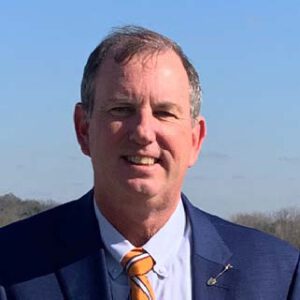Charlotte Water in North Carolina is working on a major refurbishment program to improve its McAlpine Creek Wastewater Facility and address the aging of the infrastructure, some of which dates back to the 1960s. The project aims to rehab the heart of the plant, and will involve refurbishing or replacing aeration systems, blowers, and clarifiers and performing recoating of selected elements. In this interview, Charlotte Water’s deputy utilities director for operations, Ron Hargrove, tells Municipal Water Leader more about this major undertaking and about the utility as a whole.
Municipal Water Leader: Please tell us about your background, your work experience, and how you got involved in water.
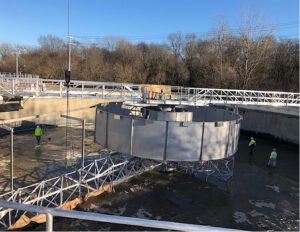
Ron Hargrove: I graduated from Clemson University in 1987 with a bachelor of science in microbiology and wound up getting a job at the environmental lab of an engineering firm in Greenwood, South Carolina. Through that, I was introduced to water. One of my first projects was taking samples along a river in Virginia for a proposed paper mill expansion project. That is how I learned about effluents and their effects on water quality.
I worked for a little while for a hazardous waste incinerator, where I treated the cooling water from the scrubber. There was a pretreatment system to reduce the amount of heavy metals that was discharged to the city’s collection system. In 1989, I got a job at Charlotte Mecklenburg Utility Department, now known as Charlotte Water, and I’ve been in a municipal career ever since. I started out as a senior chemist in the lab, overseeing the daily water treatment process control. I also performed distribution system monitoring to ensure that all regulations were met and responded to customer water quality complaints.
The 1990 lead and copper rule was the biggest regulatory event of the period. I was the lead staff member identifying our tier 1 sites and performing monitoring. Charlotte had great compliance levels due to the corrosion control it employed, and it passed with flying colors. That showed me how regulations directly affect utility workers and the work of treatment plants. I left Charlotte after about 4 years and moved to Winston-Salem, North Carolina, where I was hired as the manager of the City of Winston-Salem’s water quality laboratory. I was then promoted a couple of times and ended up as the deputy utilities director in charge of water and wastewater operations in 2002. In 2013, I became utilities director, in which position I oversaw water, wastewater, and the city’s landfills.
In 2016, I wanted to move closer to home, and so I accepted an opportunity to become Charlotte Water’s deputy utilities director for operations. My current responsibilities include the water and wastewater treatment divisions and our maintenance division.
Municipal Water Leader: Please tell us about Charlotte Water’s water and wastewater services.
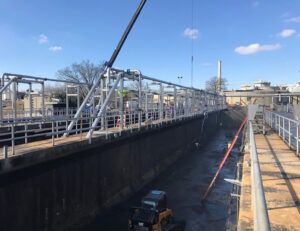
Ron Hargrove: Our system includes three water treatment facilities with a combined capacity of 174 million gallons a day (MGD). Our environmental management division includes our five wastewater treatment facilities; system protection, which includes pretreatment and our fats, oils, and greases program; biosolids management; and our water quality program. The maintenance division includes our water and wastewater treatment plant maintenance staff, our lift station maintenance, a facilities and buildings maintenance group, and our electrical and instrumentation staff. All combined, there are 245 hard-working, committed team members who come to work each day to ensure our drinking water and the water discharged back to the streams is the best quality it can be and that our facilities are well maintained and in good operating condition.
Charlotte Water is one of the largest systems in the Southeast. We manage and maintain approximately 9,000 combined miles of water distribution and wastewater collection piping. We have 10 water and wastewater treatment facilities and 7 additional facilities that contain our other operating, engineering, laboratory, and administrative functions. We have just over 1,000 full-time employees, and our operating and capital budget for fiscal year 2021 is $461 million.
Municipal Water Leader: Where does Charlotte get its water, and how many people do you serve?
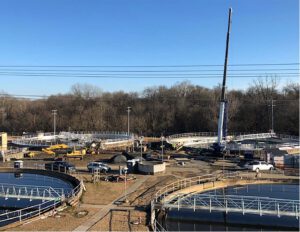
Ron Hargrove: We have two intakes, both in the Catawba River basin. One intake is in Lake Norman, which is a little north of Charlotte. Our largest intake, which is our historic intake, is in Mountain Island Lake. They’re both Duke Energy impoundments with power production. We’ve had an intake since before the reservoir was built in the early 1900s. We have the ability to withdraw a total of about 500 MGD. Our average water demand is around 107 MGD. We serve about a million people in the Charlotte-Mecklenburg area and have approximately 300,000 water connections. We also have water interconnections with most of our neighbors and bordering counties, including a few in South Carolina.
Municipal Water Leader: What is the total capacity of Charlotte Water’s five wastewater treatment plants?
Ron Hargrove: We have five major wastewater treatment plants, and through some acquisitions, we also operate two package plants. The total capacity of the five major plants is 123 MGD. The two package plants add another 150,000 gallons a day. Sometimes, they are the more troublesome of the plants that we operate. Our average demand is around 90 MGD. These plants serve roughly the same number of people that we provide with potable water—around a million.
Municipal Water Leader: How does the McAlpine Creek Wastewater Facility fit in in terms of capacity and customers?
Ron Hargrove: Up until Raleigh recently increased its plant capacity, McAlpine was the largest wastewater treatment facility between Atlanta and Richmond. The McAlpine plant is rated at a capacity of 64 MGD and treats an average of 50 MGD. It’s a regional plant and serves about two-thirds of our system. In terms of flow, it does about 55 percent of our treatment.
We have some of the oldest activated-sludge plants in the nation. They were built in the early 1920s. As the plants have aged and the system has grown, flows are bypassed around them so that they don’t get overloaded; those flows are treated at McAlpine.
Municipal Water Leader: Please tell us about the ongoing improvements to the McAlpine Creek Wastewater Facility.
Ron Hargrove: The plant was originally built in the early 1960s and came online in 1966. It has undergone many upgrades, expansions, and improvements over time. It’s actually two plants on the same site. There’s a lot of brick, mortar, and pipe infrastructure on site. Our recent improvements are intended to address the aging of the infrastructure. We had 28 aeration tanks and 16 secondary clarifiers that were at the end of their life cycles. We needed to go in and rehab the heart of the plant, so to speak. We are changing out the aeration systems in all the basins, we’re changing out our blowers, and we’re putting new mechanisms in all the secondary clarifiers. The project will cost about $120 million. We have to keep the plant operating throughout, so it has to be done in sections. It’s going to take about 5 years to get through everything.
Municipal Water Leader: What effects will the project have when it is complete?
Ron Hargrove: We are replacing the aeration system and installing high-efficiency blowers, so we hope to save money on electricity. We are replacing the tube-style diffusers in our existing aeration system with membrane diffusers in all the basins. Our final clarifier mechanisms will be stainless steel, and the floor of the clarifiers will be improved so that they do not cause any problems with solids removal. We also are replacing some of the major electrical components in the plant to provide more reliability and redundancy. This project will extend the useful life of these systems by 30 years.
McAlpine has to operate under a phosphorus nutrient limit that resulted from a potential lawsuit between the U.S. Environmental Protection Agency, South Carolina, and North Carolina. We elected in the early 2000s to receive a phosphorus limit. Right now, our process includes chemical phosphorus removal. As an initial step in this project, we installed a full-scale pilot fermentation basin, which gave the designers the data needed to complete a BioWin model of our facility and allowed us to consider changing our process from chemical to biological nutrient removal. After 9 months of piloting, we saw that a fermenter might pay huge dividends and allow us to cut our ferric chloride usage in half. We hope to achieve both chemical savings and energy savings by converting to a biological nutrient-removal process. The pilot also allowed our operations staff to learn the pros and cons of operating fermentation basins and to gain experience with different processes and process control methods.
Municipal Water Leader: Is that a treatment for solid or liquid waste?
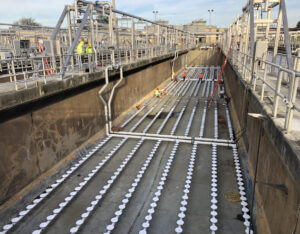
Ron Hargrove: It would remove most of the phosphorus from the liquid stream and add it to the solids stream. Down the road, we’re going to invest in nutrient harvesting so that when we dewater the solids, we can treat the side stream and convert the phosphorus to a pelletized phosphate product. That’s not part of this project, though.
Over the next 8–10 years, we will build a thermal hydrolysis process (THP) system here to treat our biosolids. Because the McAlpine plant is so large, it has become our regional biosolids treatment facility, and we will build the THP system there. That system will further treat our biosolids, convert them to a class A product, and diversify our disposal options. One of our plants already conveys its solids to McAlpine. We plan to build pipelines from two other facilities to McAlpine and perform all the solids treatment there.
Municipal Water Leader: What is the biggest obstacle you are working to overcome with your current project?
Ron Hargrove: The biggest obstacle is that it’s a design-build project. It’s the first rehabilitation of a treatment facility that we have done by means of the design-build process. We’ve done other projects via the design-build-delivery process, including one at McAlpine. Coordination among the various teams—the design-builder, Garney Construction; its engineer, Brown and Caldwell; the Charlotte Water engineering and operations team; and our owner’s advisor, Black and Veatch—is critical to making this project a success. Coordinating all the teams and making sure they were communicating and on the same page has probably been the biggest obstacle, particularly because this was such a large plant with such an involved operations team. We seemed to be spinning our wheels at the beginning. One of the things that made the biggest difference is that we formed an executive committee made up of the leaders of each group. They got together and set a schedule goal and a budget goal for the team. When we established those targets, the team really came together and started developing a path to meet them. Everybody had their own goals until we brought the committee together. It made the team a lot more efficient.
Second, our Charlotte Water team was concerned with making sure that we were building an improvement that would be forward thinking and flexible enough to accommodate potentially stricter permit limits in the future. This concern inspired us to form a blue-ribbon committee to provide ideas and recommendations to Charlotte Water and the design-build team that would provide a better outcome from a process standpoint. We asked most of the major consultants that we work with to have their process experts come to Charlotte for a day to chat about how we could design this improvement in such a way that we would guarantee that we would have flexibility in our process in the future. The committee members put their heads together and came up with the idea of doing a full-scale pilot to try out some ideas. The pilot taught us that a fermenter would benefit us; that the aeration grid could be modified and expanded to provide more aeration; and that our basins could be further compartmentalized, which would help us should we need to convert the basins to something different down the road. The pilot was expensive but well worth the cost.
Municipal Water Leader: Do you have additional advice for folks who are considering major infrastructure improvements?
Ron Hargrove: Be forward thinking. Think about what may come down the road and make sure that your improvements aren’t something you will have to undo in the future. Design-build has been a good experience, although the budget was a challenge. I think our first estimate of all the things that we dreamed of changing exceeded our budget by a third. With the design-builder on board, there was a value engineering process that was embedded in the cost estimating. That provided a lot of benefits in a major rehab project like this. Local or state laws in each area govern the possibilities for design-build, but I wouldn’t be afraid to try it again somewhere, because I think it provided us the benefit of having a good contractor. We have confidence in our contractor and in meeting our schedule. We got an idea of the cost as we made decisions, which I think has proven to be beneficial.
Municipal Water Leader: Are you resurfacing your concrete?
Ron Hargrove: We had a big debate about that. The design-build team brought in experts from Brown and Caldwell, Black and Veatch, and Warren Environmental to look at the basin walls and their coatings. We will be recoating strategically—just in the areas where it is necessary. Each basin will be cleaned, inspected, and recoated in areas where the deterioration is excessive; the effluent launder troughs in each basin will also be recoated. A&W Maintenance is performing the work. The complete recoating of all our basins would have cost an additional $3 million, so this strategic approach is much more manageable.
Municipal Water Leader: What is your message to Congress about water infrastructure?
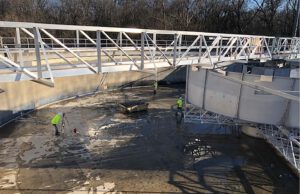
Ron Hargrove: The need increases every year. State revolving fund (SRF) funding is great for utilities that can receive it, but Charlotte is tapped out on the amount of loans that we can receive. It’s better financing than we would get elsewhere, but the cap prevents us from taking advantage of it. I understand that some smaller systems may have revenues that are too low to finance their projects, but large utilities have large capital needs as well. It would be good if Congress or the state looked at ways to finance large projects through SRF.
To give you an example, our 5‑year capital improvement plan will cost $1.9 billion. We’re planning to embark on one of our largest projects ever: building a new greenfield wastewater treatment plant, which would be our sixth. That’s a $350 million project. Right now, we cannot get any more SRF funding for it. We can apply for the Water Infrastructure Finance and Innovation Act program, but that wouldn’t work quite as well as the SRF program.
Municipal Water Leader: What thoughts do you have for recent graduates and young people who are considering careers in the water industry?
Ron Hargrove: It is all you would ever dream it to be. When I came out of school, my goals went no higher than being a guy working in a lab. By jumping in when there was an opportunity, I quickly learned how to manage people, how to solve problems, and how to make decisions. Some people are reluctant to make a decision for fear of making a bad decision, but you only learn when you make bad decisions. You learn what not to do. I never dreamed I would be a director, but timely opportunities and the faith and mentoring of people along the way got me here. Anybody can get there if I did. Without a doubt, you can achieve your career goals in the water industry.
Charlotte Water has won the utility of the future award a couple of times. There are a plethora of resources that make Charlotte Water a great place to work. The people, especially, are the reason Charlotte stays successful.
Ron Hargrove is the deputy utilities director for operations at Charlotte Water. He can be contacted at ron.hargrove@charlottenc.gov.
